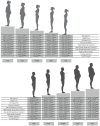New obesity classification criteria as a tool for bariatric surgery indication
- PMID: 26811617
- PMCID: PMC4716069
- DOI: 10.3748/wjg.v22.i2.681
New obesity classification criteria as a tool for bariatric surgery indication
Abstract
Obesity plays relevant pathophysiological role in the development of health problems, arising as result of complex interaction of genetic, nutritional, and metabolic factors. Due to the role of adipose tissue in lipid and glucose metabolism, and low grade inflammation, it is necessary to classify obesity on the basis of body fat composition and distribution, rather than the simply increase of body weight, and the Body Mass Index. The new term of adiposopathy (''sick fat'') clearly defines the pathogenic role of adipose tissue. Four phenotypes of obese individuals have been described: (1) normal weight obese (NWO); (2) metabolically obese normal weight; (3) metabolically healthy obese; and (4) metabolically unhealthy obese or "at risk" obese. Moreover, sarcopenic obesity has been related to all the phenotypes. The category of normal weight lean, represented by metabolically healthy normal weight has been classified to distinguish from NWO. It is crucial to recommend a bariatric surgery taking into account adiposopathy and sick fat that occurs with the expansion of fat mass, changing the inflammatory and metabolic profile of the patient. Body fat percentage and genetic polymorphism have to be evaluated to personalize the best bariatric surgery intervention.
Keywords: Adiposopathy; Fat mass; Laparoscopic gastric banding; Metabolically healthy normal weight; Metabolically healthy obese; Metabolically obese normal weight; Metabolically unhealthy obese; Normal weight lean; Normal weight obese; Obesity.
Figures


References
-
- American Medical Association. Council on Science and Public Health Report, 2013
-
- Obesity: preventing and managing the global epidemic. Report of a WHO consultation. World Health Organ Tech Rep Ser. 2000;894:i–xii, 1-253. - PubMed
-
- Recognition of Obesity as a Disease. Available from: http://www.npr.org/documents/2013/jun/ama-resolution-besity.pdf.
-
- Bray GA, Bellanger T. Epidemiology, trends, and morbidities of obesity and the metabolic syndrome. Endocrine. 2006;29:109–117. - PubMed
Publication types
MeSH terms
Substances
LinkOut - more resources
Full Text Sources
Other Literature Sources
Medical

